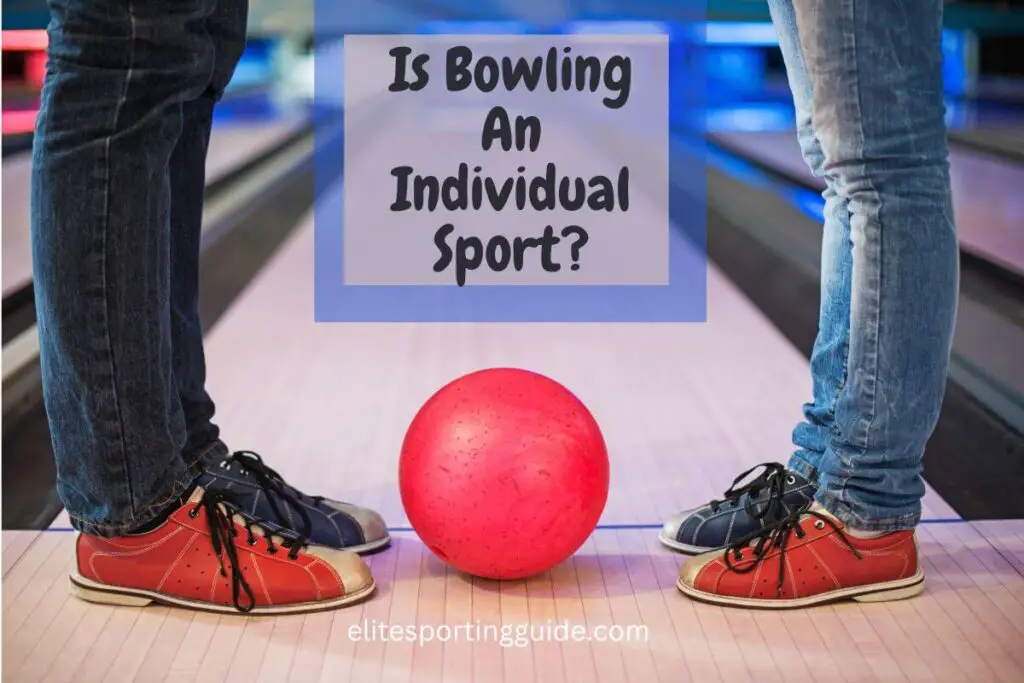When it comes to defining Bowling as a sport, a fundamental question arises: Is bowling an individual sport or does it encompass elements of team competition?
This inquiry has sparked debates among enthusiasts and professionals alike. In this article, we will explain the essence of bowling, examining its structure, rules, and the dynamics that unfold on the lanes.
By dissecting these elements, we aim to reveal whether bowling can be classified as an individual sport or if there is more to the game than meets the eye.
Is Bowling An Individual Sport?
Yes, bowling is generally considered an individual sport. While it can also be played in a team format, with multiple players on each team, the core essence of bowling revolves around individual performance and skill.
In a typical bowling game, each player takes their turn to roll the ball down the lane and score points based on their own performance.
The objective is to knock down as many pins as possible in each frame and accumulate the highest score. Players rely on their own technique, accuracy, and strategic decision-making to achieve success in the game.
However, it’s worth noting that bowling can also be enjoyed as a team sport in formats such as league play, where teams compete against each other, and the cumulative scores of individual team members contribute to the overall team score.
The Origins and Evolution of Bowling: Understanding its Sporting Classification
Bowling, with its roots stretching back thousands of years, has a rich history that spans various cultures and civilizations.
From its humble beginnings as a leisure activity to its classification as a competitive sport, the evolution of bowling has been a fascinating journey. Exploring its origins and tracing the trajectory of its development provides valuable insights into understanding its sporting classification today.
The earliest evidence of bowling-like games can be found in ancient civilizations such as Egypt and Rome, where fragments of balls and pins have been discovered.
However, it was during the Middle Ages that bowling began to gain popularity in Europe, taking on different forms and rules depending on the region. From “Ninepins” in Germany to “Skittles” in England, these early versions laid the groundwork for the modern game we know today.
It was during the colonial era in America that bowling truly flourished. Immigrants brought their own variations of the game, and it quickly became a favorite recreational activity among the settlers.
Bowling alleys began to emerge, and the game’s popularity spread rapidly.
However, it wasn’t until the 19th century that bowling began its transition from a casual pastime to a competitive sport.
Organized bowling competitions started to emerge, with players vying for prizes and recognition. Leagues were formed, providing a platform for bowlers to showcase their skills and compete against one another.
As the sport gained traction, national and international bowling associations were established to govern the rules and regulations.
One of the key aspects in understanding the sporting classification of bowling is the distinction between individual bowling and team bowling.
Individual bowling focuses on the performance of a single player, highlighting their technique, accuracy, and ability to adapt to different lane conditions. Individual tournaments and championships became prevalent, showcasing the skills and achievements of top bowlers.
On the other hand, team bowling emphasizes collaboration, strategy, and camaraderie. League play became popular, with teams competing against each other and relying on a collective effort to achieve victory
The dynamics of team bowling fostered a sense of community and allowed players to work together towards a common goal.
The classification of bowling as an individual sport or a team sport can be a subject of debate.
While individual skill and performance are central in bowling, team dynamics also play a significant role in league play and competitive formats.
Bowling organizations and regulations have grappled with defining its classification, balancing the importance of individual achievements with the essence of teamwork.
Understanding the origins and evolution of bowling provides valuable context for its sporting classification. While bowling has its roots in leisurely pastimes, it has evolved into a competitive sport that encompasses both individual and team aspects.
Appreciating the dual nature of bowling, recognizing the skill and strategy required by individual players, as well as the teamwork involved in league play, allows us to fully embrace the diverse and dynamic nature of this beloved sport.
The Mechanics of Individual Bowling: Exploring Technique, Skill, and Precision
Individual bowling is a fascinating blend of technique, skill, and precision. Mastering the mechanics of the game is essential for achieving consistent and successful performances on the lanes.
From the approach to the release, every aspect of a bowler’s execution plays a crucial role in determining the outcome. Exploring the mechanics of individual bowling allows us to appreciate the intricacies of the sport and the dedication required to excel.
The first fundamental aspect is the approach, where the bowler takes measured steps towards the foul line, preparing for the release.
Balancing speed, rhythm, and timing are crucial components, as a well-executed approach sets the stage for a powerful and accurate delivery.
Proper footwork and body alignment help maintain balance and generate the desired ball speed.
Next comes the grip and release. Bowlers carefully select a ball that suits their style and preferences. The grip should provide a comfortable and secure hold, enabling the bowler to maintain control throughout the release.
Skillful bowlers employ various release techniques, such as the traditional straight release, the hook, or the spin, each requiring a different hand and wrist action to achieve the desired ball motion.
Precision in targeting is another critical aspect. Aiming at the desired spot on the lane, often marked by arrows or dots, is crucial for consistent results.
Bowlers must consider the lane conditions, oil patterns, and adjust their target accordingly.
Adjusting the angle of the throw, known as the “line,” can help maximize pin carry and increase the chances of achieving strikes or spare conversions.
Related post: Is Bowling An Olympic Sport?
Psychological Aspects of Individual Bowling: Focus, Concentration, and Mental Stamina

Psychological aspects play a crucial role in individual bowling, particularly in terms of focus, concentration, and mental stamina.
Maintaining unwavering focus throughout a game can be a challenge due to various distractions, but it is essential for optimal performance.
Bowlers need to develop strategies to block out external stimuli and stay fully engaged in each shot. This may involve establishing pre-shot rituals, visualizing successful outcomes, or employing deep breathing techniques to center the mind.
Alongside focus, concentration is vital for executing shots with precision and confidence. Bowlers must learn to stay present in the moment, shutting out thoughts of past frames or future outcomes.
Lastly, mental stamina is key in individual bowling, as it enables bowlers to endure long competitions, stay resilient in the face of challenges, and maintain a high level of performance throughout the game.
Developing mental resilience and the ability to adapt to changing conditions or unexpected results are essential components of a bowler’s psychological toolkit.
Individual Strategy in Bowling: Reading the Lanes, Adjusting Shots, and Making Decisions
Individual strategy in bowling revolves around the ability to read the lanes, make necessary adjustments to shots, and make informed decisions throughout the game.
Reading the lanes involves analyzing the oil patterns and lane conditions to determine how the ball will react.
By observing the ball’s trajectory and pin carry, bowlers can assess the best line and target to maximize their scoring potential.
Adjustments to shots may be required based on lane transitions, where the oil pattern changes over time. Bowlers may alter their starting position, target, or ball speed to adapt to the evolving conditions.
Making decisions in bowling involves selecting the right equipment, determining the appropriate line and targeting, and evaluating risk versus reward.
Bowlers must consider their skill level, the scoring situation, and their overall game plan to make the most effective choices.
Individual strategy in bowling is a combination of technical expertise, lane awareness, and strategic decision-making to optimize performance and achieve the desired results.
The Role of Equipment in Individual Bowling: Selecting the Right Ball, Weight, and Accessories
The role of equipment in individual bowling is critical for achieving optimal performance. Bowlers must carefully select the right ball, weight, and accessories to suit their individual style and preferences.
The choice of ball is vital, considering factors such as coverstock material, core design, and surface texture.
Bowlers may opt for reactive resin, urethane, or plastic coverstocks, depending on lane conditions and desired ball reaction.
Selecting the appropriate weight is also essential, as it affects a bowler’s control and delivery. Properly fitted finger holes and a comfortable grip are necessary for consistent release and accuracy
Additionally, accessories such as wrist supports (wrist device), thumb tape, or shoe sliders can aid in fine-tuning technique and enhancing performance.
The role of equipment in individual bowling extends beyond mere tools—it is a personalized arsenal that allows bowlers to optimize their game and adapt to varying lane conditions.
League Play: How Team Dynamics Influence Individual Performance in Bowling
League play in bowling is a unique blend of individual skill and team dynamics, where the influence of teamwork on individual performance is evident.
While bowling is often considered an individual sport, participating in a league introduces a collaborative aspect that can greatly impact bowlers.
Team dynamics play an important role in cultivating a supportive and motivating environment. Teammates provide encouragement, share insights, and offer constructive feedback, which can help individual bowlers improve their game.
The sense of sportsmanship and shared goals in a team setting can alleviate pressure and raise confidence, leading to enhanced focus and performance.
Additionally, in league play, individual scores contribute to the overall team score, creating a sense of accountability and motivation.
The interplay between team dynamics and individual performance in league play underscores the significance of teamwork and its potential to elevate each bowler’s game to new heights.
The Impact of Coaching and Training on Individual Bowling Success
Coaching and training play a pivotal role in shaping the success of individual bowlers.
Through personalized guidance, technical instruction, and strategic insights, coaches provide invaluable support to enhance a bowler’s skills and overall performance.
One of the key impacts of coaching is the refinement of technique. Coaches analyze a bowler’s approach, release, and overall mechanics, identifying areas for improvement and implementing targeted training regimens.
They provide feedback on body positioning, hand placement, and timing, helping bowlers develop a consistent and effective bowling style.
Coaches also contribute to the mental aspect of bowling. They assist bowlers in building mental resilience, focusing on concentration, and managing performance anxiety.
Through various techniques such as visualization exercises and positive reinforcement, coaches help bowlers strengthen their mental game, enabling them to maintain composure and perform at their best under pressure.
Training is another fundamental component in individual bowling success. Coaches design training programs that include physical conditioning, practice drills, and competitive simulations.
By emphasizing proper warm-ups, strength conditioning, and flexibility exercises, coaches help bowlers improve physical fitness, which contributes to better control and endurance on the lanes.
Structured practice drills, such as spare shooting exercises and lane targeting challenges, enhance accuracy and consistency. Coaches also simulate game scenarios, allowing bowlers to experience different lane conditions and practice making strategic decisions in a controlled environment.
This type of training sharpens decision-making skills, enhances adaptability, and builds confidence in a variety of situations.
The impact of coaching and training on individual bowling success cannot be overstated. Coaches provide technical guidance, mental support, and personalized training to unlock a bowler’s potential.
With their expertise and guidance, bowlers can refine their technique, develop a strong mental game, and continuously improve their skills. The combination of coaching and training creates a solid foundation for individual success in bowling, empowering bowlers to achieve their goals and excel in the sport.
The Competitive Landscape: Individual Tournaments and Championships in Bowling
Within the realm of bowling, individual tournaments and championships form the pinnacle of competitive play.
These events bring together the most skilled bowlers from around the world to showcase their talent and vie for prestigious titles.
Individual tournaments offer a platform for bowlers to test their skills against formidable opponents, pushing themselves to new limits and demonstrating their prowess.
The landscape of individual bowling tournaments is diverse, ranging from local competitions to regional, national, and even international events.
At the local level, bowlers can participate in weekly leagues and smaller-scale tournaments that provide opportunities for honing their skills and gaining experience.
These grassroots competitions often serve as stepping stones for bowlers aspiring to compete at higher levels.
Regional tournaments attract bowlers from larger areas, such as states or provinces, who vie for titles and qualifying spots in higher-tier competitions. These events showcase the depth of talent within a specific region and act as a gateway for bowlers to progress to national or international stages.
National tournaments bring together top bowlers from across a country, pitting them against each other in a battle for national recognition and glory.
These events are highly competitive, often spanning multiple days and featuring various formats, including singles, doubles, and team events.
National championships provide a stage for bowlers to showcase their skills, earn accolades, and cement their status as some of the best in their respective countries.
At the pinnacle of individual bowling, international championships gather elite bowlers from around the globe to compete for coveted titles and represent their nations.
These high-profile events, such as the World Bowling Championships, showcase the highest level of skill and offer a platform for international recognition.
Bowlers competing in international tournaments face the challenge of adapting to unfamiliar lane conditions, different playing styles, and intense competition, pushing themselves to the limits of their abilities.
The competitive landscape of individual bowling tournaments fosters a spirit of excellence, community, and sportsmanship. Bowlers train tirelessly, refine their techniques, and constantly seek to improve their performance in preparation for these prestigious events.
Whether competing at the local, national, or international level, individual tournaments and championships in bowling provide a thrilling showcase of skill, determination, and the pursuit of greatness.
Related post: What type of Activity Is Bowling?



